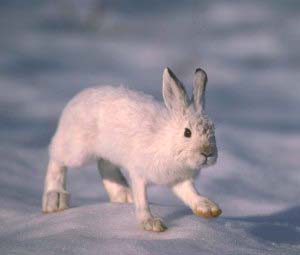Ukaliq — Arctic Hare
Ukaliq or ukqaliarjuk, the arctic hare, is a small prey animal. Inuit do not rely on it as a major food source, but it often serves as a welcome supplement to a diet of caribou and marine mammals, and has frequently staved off starvation when larger game failed to appear. It is known as the most mobile of the “small” animals (hares, siksiks, and lemmings), moving across the tundra seeking plants to eat. It hides behind and beneath rocks, where it also raises its young, although it does not dig a proper burrow. Hares give birth to a few offspring in early summer, around the time of the first flowers. Young hares nurse for less time than wolf or fox cubs. Once they grow big enough to run about, the young begin to change to a diet of various plants known collectively as iviit. Ukaliq feeds mainly at night, and rests during the day. When fall comes and snow and ice cover the ground vegetation, hares begin to eat quajauti, the orange and black lichens that cover many rocks. Food is scarce and many hares face starvation during this time. Unfortunately, ukaliq has to content itself with this meager vegetation instead of hunting a meal, as one legendary hare tried to do. The tale of “the fox and the hare” tells how a hare married a female fox, promising to provide her with all the prey she needed to eat. Sadly, however, he was unable to live up to his job and, full of shame, told her that they should separate since he was unable to look after her. Full of tears, she left him, mourning the loss of her hare husband (Randa 1994).
Although it is seen as more mobile than other small mammals, many terms used to describe ukaliq focus on its periods of immobility. When a hare sits still, with its ears folded back against its head, it is known as qilimiktuq, which suggests that the hare’s ears look like “two kayaks bound together to make a raft or catamaran”. The Inuit say that a hare in this position plans to stay put for a long time, whereas when its ears are held straight up “like when it is carrying somebody on its shoulders” (kakaviktuq), it will soon be running off again. In spite of the hare’s ability to run and hide, it is still regarded as the animal with the highest mortality on the tundra. All the Artic predators, from the tiny ermine up to the Inuit themselves, enjoy eating ukaliq (Randa 1994).
Although arctic hares did not constitute a large source of food or clothing, the Inuit valued them enough to try to reduce the numbers of predatory falcons and owls that, as they said, “wasted ptarmigans and rabbits” (IOHP 004). Hare skins are too delicate for hard use, but warm and comfortable when made into sleeping bags for children. The soft and pliable skins or subcutaneous membranes of ukaliq were used medicinally to place on cuts and boils, and tiny tufts of its hair could be used in making seal indicators, if ptarmigan down was not available. The mammary glands of hares had many useful powers and were used against stomach aches, as well as to help mothers to produce more nourishing milk (IOHP 412, 004, 192; Randa 1994).

